History of Property Lines and Streets: A Brief Overview
Property lines and street boundaries didn’t just come out of thin air. Historically, these were established based on land grants, geography, and sometimes even disputes. Dive into the roots and you’ll find tales of trade-offs, bargains, and even conflicts.
- The Era of Kings and Queens: In ancient times, lands were divided at the behest of the ruling monarch.
- Colonial Times: As explorers claimed lands, divisions became more systematic yet disputed.
- Modern-Day Surveys: With advancements in technology, accurate measurements are now the norm.
Legal Implications of Overstepping Boundaries
Who would’ve thought a few feet could cause such a ruckus? Well, when it comes to property lines, overstepping – even inadvertently – can have serious legal consequences. For example, building a structure that encroaches upon public land can result in penalties or even demolition orders.
Using Professional Surveys: Precision Matters
When you need to be sure about your property’s boundaries, especially regarding its commencement from the street, calling in the professionals is a no-brainer. Surveyors use sophisticated tools to provide accurate readings. After all, would you rather trust a decades-old fence or a modern-day laser measurement?
The Role of Deeds and Historical Documents
Your property’s deed isn’t just a piece of paper – it’s a treasure trove of information. Alongside the description of your property’s size and boundaries, it often provides clues about its starting point relative to the street.
- Older Deeds: These might use natural landmarks or neighboring properties as reference points.
- Modern Deeds: Typically use metes and bounds, a system of describing land using distances and angles.
Municipal Codes and Local Regulations: The Oversight Bodies
Different places, different rules. While a broad understanding of property lines is useful, one must never overlook local regulations. Cities or municipalities often have specific guidelines about property boundaries, especially concerning streets.
Public vs. Private: Understanding Street Ownership
It’s a common misconception that all streets are public. In fact, some streets are privately owned, which can significantly impact where property lines begin. Delve into the nuances and ensure you’re on the right side of the line.
- Public Streets: Typically maintained by the local government. Property lines usually start a specific distance from the center of the street or its edge.
- Private Streets: Often owned by homeowners or businesses. Property lines might extend up to the street itself or have specific delineations.
Practical Tips to Identify Your Property Line from the Street
- Fences and Walls: While not foolproof, they’re often good indicators.
- Neighbors: Sometimes, a friendly chat can provide insights.
- Local Land Records Office: A goldmine for official records and maps.
Common Myths and Misconceptions
There’s no shortage of myths when it comes to property boundaries. From “my tree is on their side, so it’s their responsibility” to “the sidewalk marks the start of my property”, debunking these myths can save you a lot of headaches.

The Importance of Landscaping in Relation to Property Lines
When discussing where your property line starts from the street, landscaping can’t be overlooked. Landscaping not only adds aesthetic value to your property but also plays a vital role in demarcating boundaries. Have you ever noticed how some homes have trees, shrubs, or flower beds lining the edge of their properties? These natural markers often align closely with property lines.
- Trees and Large Plants: While they make for beautiful boundary markers, always ensure they don’t encroach on public areas or obstruct views for traffic. When planting, consider how big the tree or shrub will grow to avoid future complications.
- Flower Beds and Small Shrubs: These are often used to beautify the boundary line without creating obstructions. Their maintenance can provide a clear demarcation of where one’s property begins.
- Hardscaping Elements: Think of pathways, stones, or even low fences. These elements can clearly define where your property line starts from the street.
Setbacks and Easements: A Deeper Dive
Another critical aspect when considering where your property line starts from the street is understanding setbacks and easements. These terms might sound complex, but they have practical implications for homeowners.
Setbacks
These are specific distances from the property line within which you cannot build any permanent structures. Local municipalities set them to ensure safety, access, and sometimes, aesthetic standards.
Easements
An easement gives someone the right to use a part of your property for a specific purpose. Common types include utility easements, where utility companies might have the right to place poles or lines, and access easements, allowing someone to cross a part of your property to reach theirs.
| Term | Description | Example |
| Setback | A mandatory space between a property’s boundary and a structure. | A town might require homes to be built at least 20 feet away from the street. |
| Easement | A granted right to use a part of someone’s property for a particular purpose. | An electricity company might have an easement to install power lines on the edge of your property. |
Understanding both setbacks and easements can significantly affect decisions regarding constructions, landscaping, and even property purchases. Always review local codes and property deeds to get clarity on these aspects related to where your property line starts from the street.
Conclusion
Identifying where your property line starts from the street might seem daunting, but with the right knowledge and tools, it becomes manageable. Whether you’re planning a new construction or simply want to understand your land better, a clear comprehension of boundaries is invaluable.
FAQs
How often should I get my property surveyed?
While there’s no strict rule, consider a survey if you’re planning major renovations or suspect boundary discrepancies.
Can I rely on online maps for accurate property lines?
Online maps provide a general idea but always consult official records or professionals for precision.
What if my neighbor and I disagree on our property line?
Consult your deeds, consider a joint survey, or seek legal counsel if disputes persist.
Does a fence establish a new property line?
No, while fences might indicate boundaries, they don’t legally establish them.
Are there penalties for encroaching on public land?
Yes, penalties range from fines to mandated removal of encroachments.








+ There are no comments
Add yours